|
|
|
Sort Order |
|
|
|
Items / Page
|
|
|
|
|
|
|
| Srl | Item |
| 1 |
ID:
074087
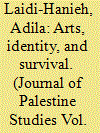

|
|
|
|
|
| Publication |
2006.
|
| Summary/Abstract |
This personal account, by the first director (1996–2005) of the Sakakini Center in Ramallah, describes the rewards and difficulties of establishing and running an NGO dedicated to culture and the arts in occupied Palestine. In the process of recounting the story of the center—its vision and objectives, multidisciplinary programming, funding constraints, its efforts to develop a diversified audience, and the impact of the second intifada—the author touches on a number of broader issues. These include the NGO scene in Palestine, international donor agendas, the inevitable intertwining of culture and politics, questions of identity and survival, and the challenge of finding ways to impart meaning to the arts in a situation of scarcity and siege.
|
|
|
|
|
|
|
|
|
|
|
|
|
|
|
|
| 2 |
ID:
127946
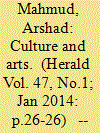

|
|
|
| 3 |
ID:
145335


|
|
|
| 4 |
ID:
165125


|
|
|
|
|
| Summary/Abstract |
Interventions such as courts and truth commissions are elements of an internationally established transitional justice (TJ) toolkit. Such measures are rarely sustainable or in place after the occurrence of mass violence. Those affected then have to themselves get active to restore social relationships. Civil society plays an important role in these transitions, but civil society also needs to be scrutinised to deconstruct reductionist conceptualisations in TJ discourses. Taking the Moluccan conflict and peace process as a case study, this paper looks into alternative ways that communities seek to transition from violence to peace and in the process ask for forms of justice not exclusively related to physical violence. Instead, communities focus on continuing social injustices that they believe underlie this violence. Analysis of the case study promotes an understanding of TJ not primarily as transitional, but as transformative and performative. In this way locally driven transitional justice mechanisms look not only into the past and legacies of violence, but also into legacies of harmony and peace and the emergence of integrative means in the future. The case study shows that forms of art in Maluku were turned into a force that aimed to reintegrate society divided by violence and unite society to resist exploitation and suppression by outside forces. Young people played important roles in this dynamic. The search for reconciliation in Maluku was in this way transformed into a broader struggle against structural violence and destructive outside interventions and for social justice and sustainable peace.
|
|
|
|
|
|
|
|
|
|
|
|
|
|
|
|
| 5 |
ID:
188575
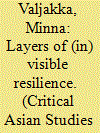

|
|
|
|
|
| Summary/Abstract |
Building on a critical gendered approach at the intersection of arts, women, and homelessness, this article calls attention to the structured layers of (in)visibilities of female agency, existence, and resilience. The arts have a special place and importance in civil society formation in relation to homelessness in Japanese cities today, so the aim is to elucidate the significant but understudied role of women in enhancing varied forms of resilience in the urban environment. Arts, activism, and, in particular, art activism on socio-political issues in Asian cities are typically perceived as methods of resistance against local and national governments, whereas their crucial contribution to urban resilience often remains unrecognized. By investigating the emergent forms of interdisciplinary arts in Tokyo and Osaka that are aimed at sustainability in less-privileged living conditions, this article contributes to the growing field of studies acknowledging how these circumstances are brought about not only by economic ruptures but also by gendered socio-structural and cultural factors. By recognizing the intricate parameters of the varied artistic practices, a more nuanced understanding of the gendered urban resilience in maintaining communities, neighborhoods, and cities can be gained.
|
|
|
|
|
|
|
|
|
|
|
|
|
|
|
|
| 6 |
ID:
114684


|
|
|
|
|
| Publication |
2012.
|
| Summary/Abstract |
In our digital age when most movies viewed at home carry Interpol warnings that copyright piracy is a crime, yet patented medicines are unaffordable for millions, ethical debates about intellectual property rights and freedom of information are becoming widespread. But a less noticed topic in these debates is the recent international effort to expand and implement Euro-American models of intellectual property law among peoples whose daily activities previously have not been covered by formal intellectual property laws (primarily copyright, patent, and trademark regulations). This essay considers how this trend is unfolding in post-Suharto Indonesia, particularly the tension between national efforts to create legal property rights over cultural resources and the fact that most ordinary Indonesians do not view their cultural knowledge and aesthetic or ritual activities as property to be claimed in an exclusive way by their ethnic group or government. Plans to legalize the cultural ownership of regional arts are addressed with ethnographic examples from Indonesian fieldwork including 2005-07 visits conducted by an international team of lawyers, musicologists, anthropologists, and Indonesian community activists with 'traditional' arts producers from eleven cultural regions in eight provinces.
|
|
|
|
|
|
|
|
|
|
|
|
|
|
|
|
| 7 |
ID:
162655


|
|
|
|
|
| Summary/Abstract |
The “aesthetic turn” is not restricted to an epistemological project (to think about international relations anew) nor to a new empirical dimension (to describe under-studied objects in the discipline); it also provides us with some teaching tools. This article draws upon the experiences in several international relations classes within the Doctoral School and the Paris School of International Affairs at SciencesPo Paris to go beyond the illustrative function of aesthetics in pedagogy. Teaching through arts is helpful for exploring the sensitive dimensions in the field and international changes in strategy and diplomacy. This article takes into account some works made by students and what these suggest about using refreshing practices to improve student skills and knowledge.
|
|
|
|
|
|
|
|
|
|
|
|
|
|
|
|
| 8 |
ID:
167650
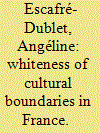

|
|
|
|
|
| Summary/Abstract |
This paper proposes to explore French cultural policy to show how the white boundary making is embedded in the ‘routine structures’ of cultural life. It takes the example of the implementation of national cultural policy as a means of seeing how the privilege of the majority operates. Against a formal insistence that the French definition of citizenship and equality does not leave room for the discussion of visible identities, it argues that immigration issues in relation to culture are relevant loci for the numerous instances of boundary drawings that it helps highlighting. Specifically, it shows how in the process of designing and implementing cultural policies, administrative officials have defined culture as artistic, universal and secular throughout the years. As a consequence of which, the privileged currently take part in the definition of artistic norms, while migration-related minorities have to justify for the social benefit of any of their artistic initiative.
|
|
|
|
|
|
|
|
|
|
|
|
|
|
|
|
| 9 |
ID:
168184
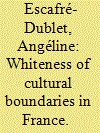

|
|
|
|
|
| Summary/Abstract |
This paper proposes to explore French cultural policy to show how the white boundary making is embedded in the ‘routine structures’ of cultural life. It takes the example of the implementation of national cultural policy as a means of seeing how the privilege of the majority operates. Against a formal insistence that the French definition of citizenship and equality does not leave room for the discussion of visible identities, it argues that immigration issues in relation to culture are relevant loci for the numerous instances of boundary drawings that it helps highlighting. Specifically, it shows how in the process of designing and implementing cultural policies, administrative officials have defined culture as artistic, universal and secular throughout the years. As a consequence of which, the privileged currently take part in the definition of artistic norms, while migration-related minorities have to justify for the social benefit of any of their artistic initiative.
|
|
|
|
|
|
|
|
|
|
|
|
|
|
|
|
|
|
|
|
|